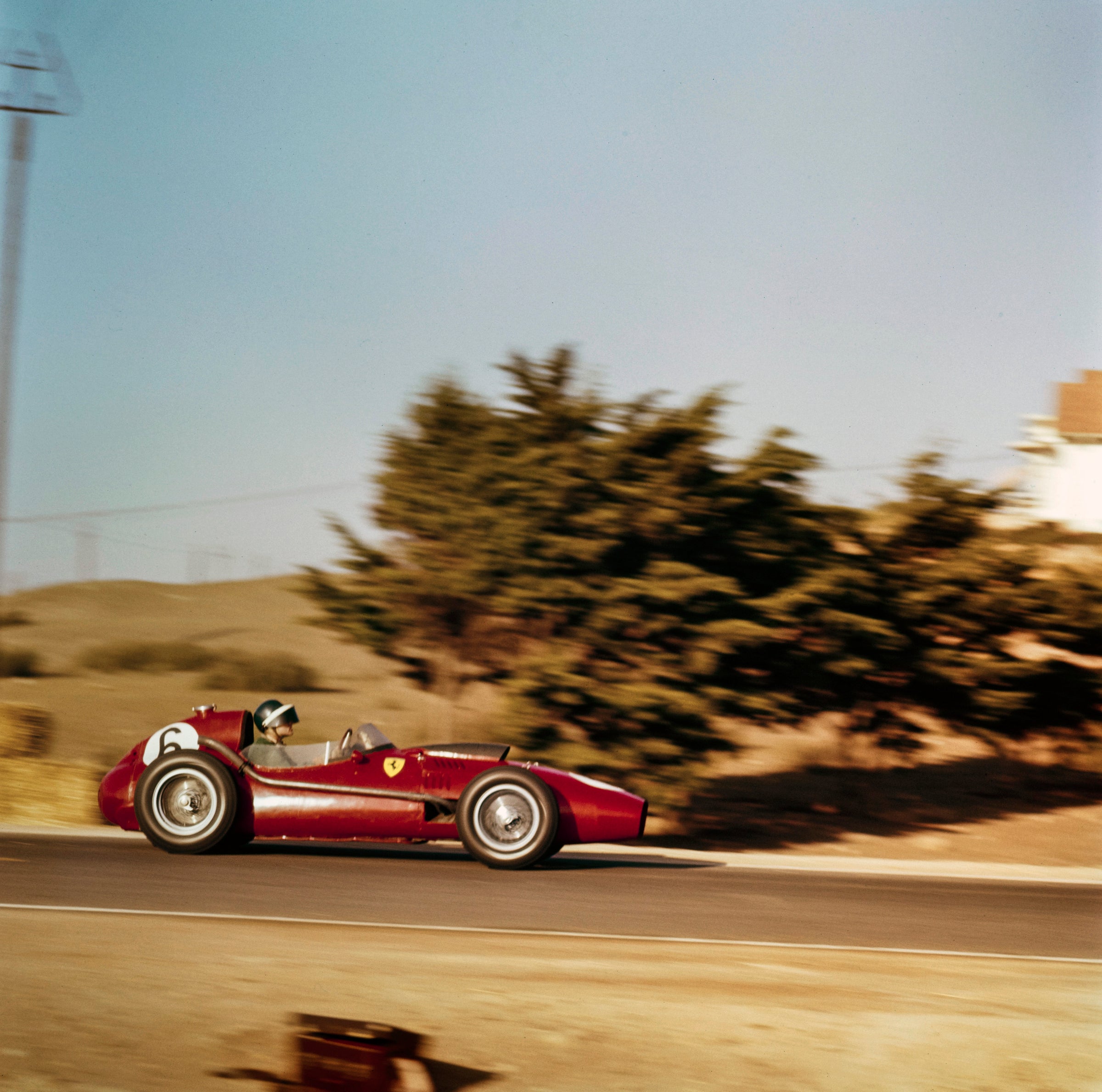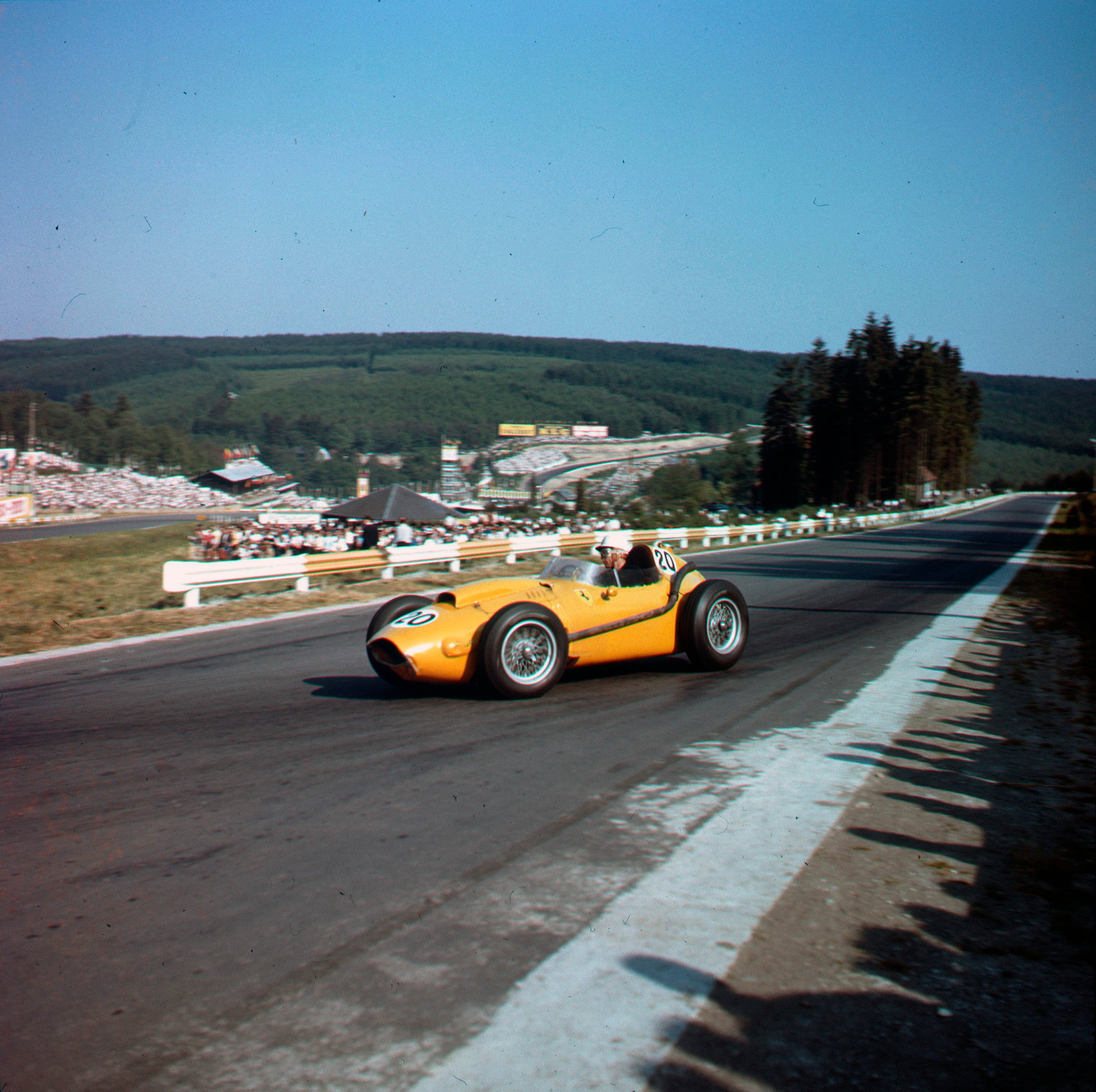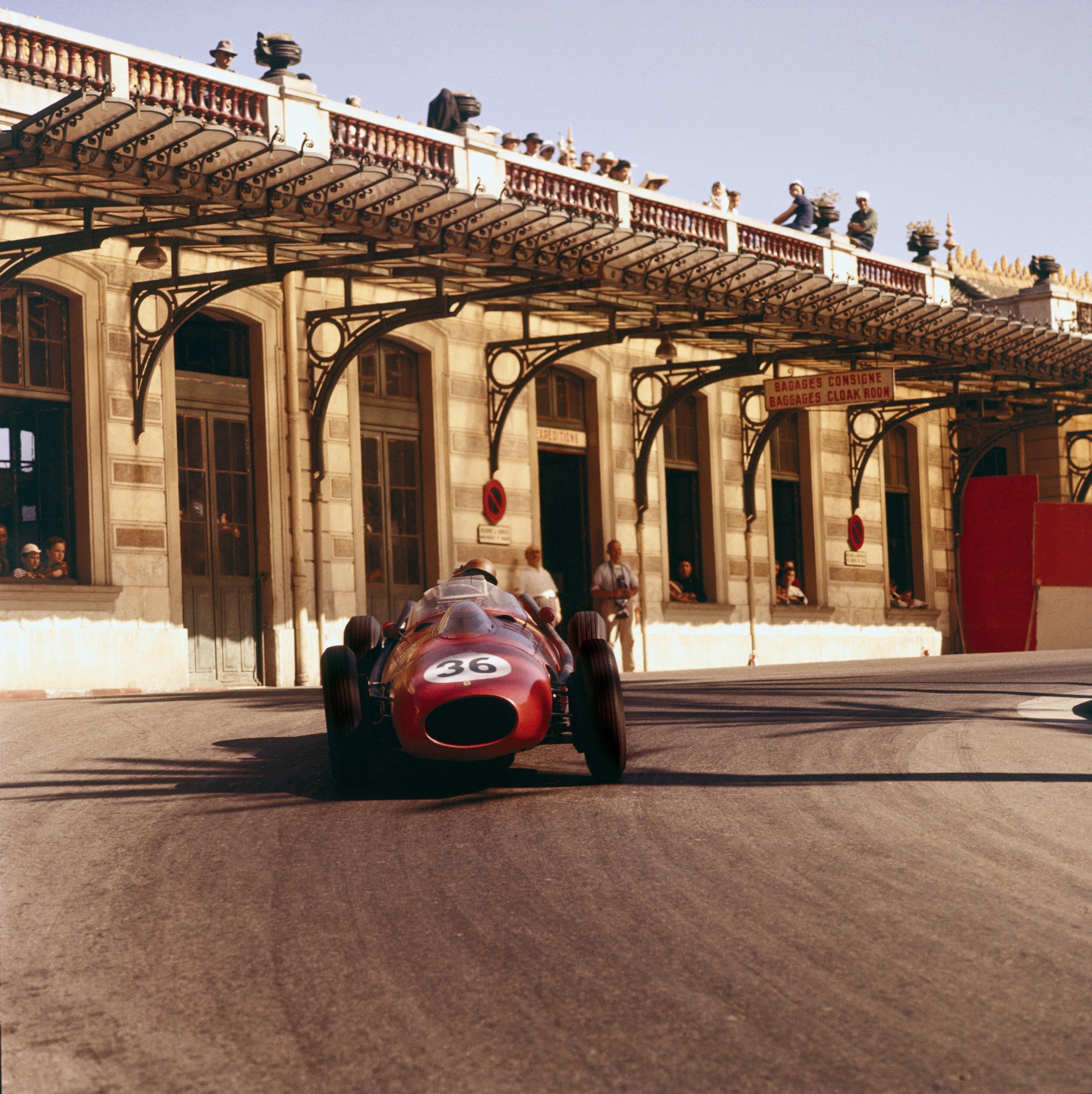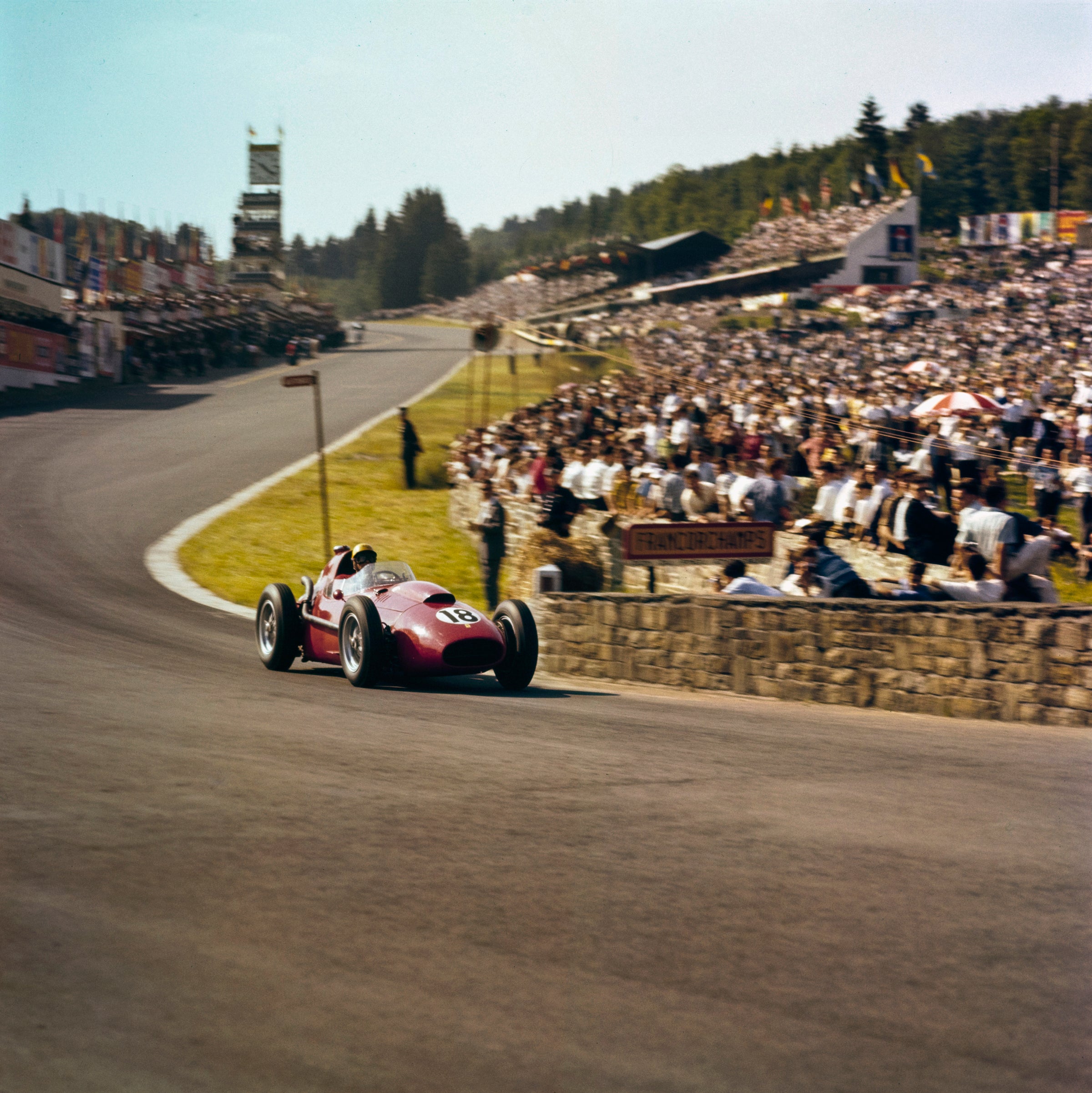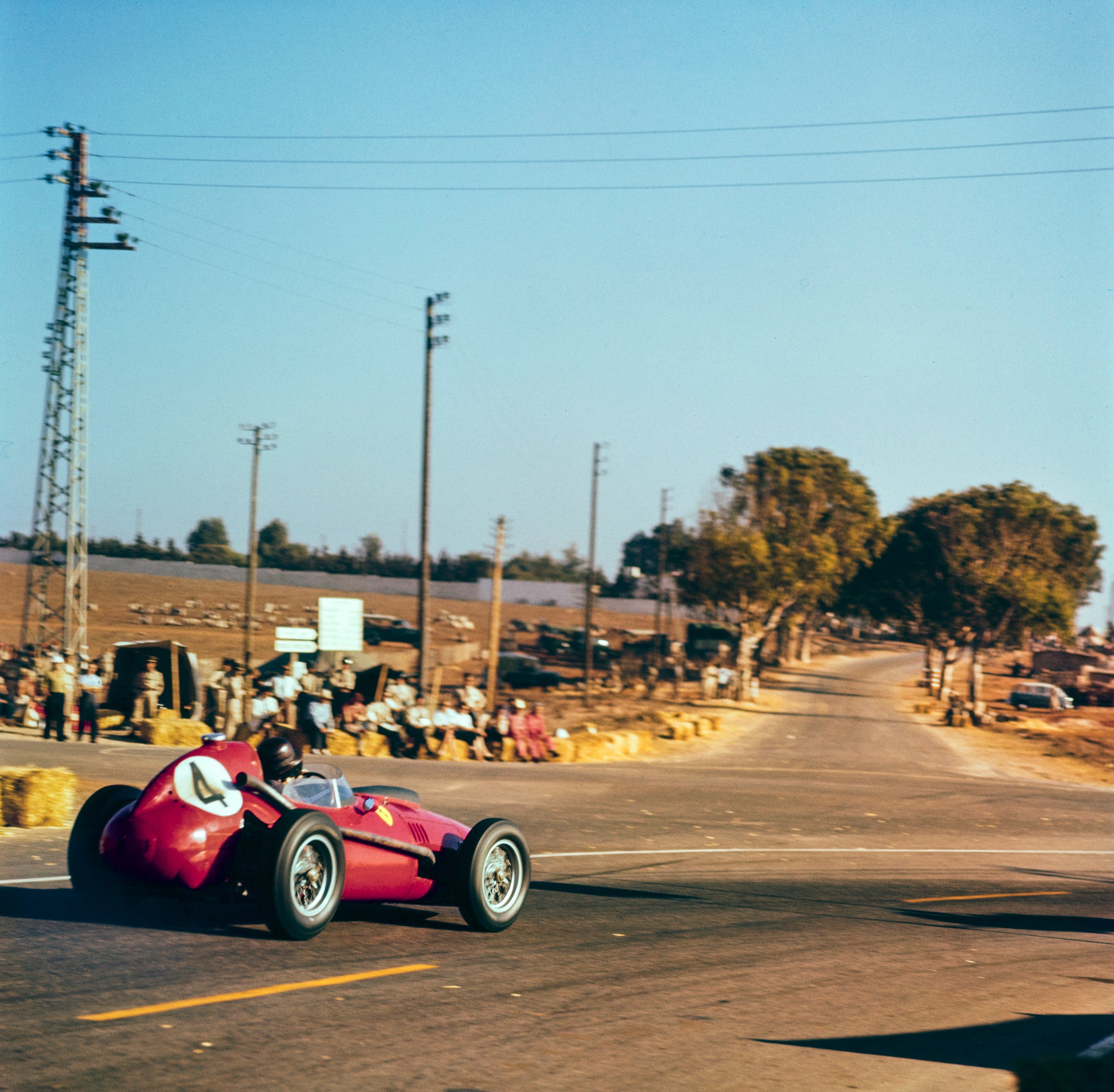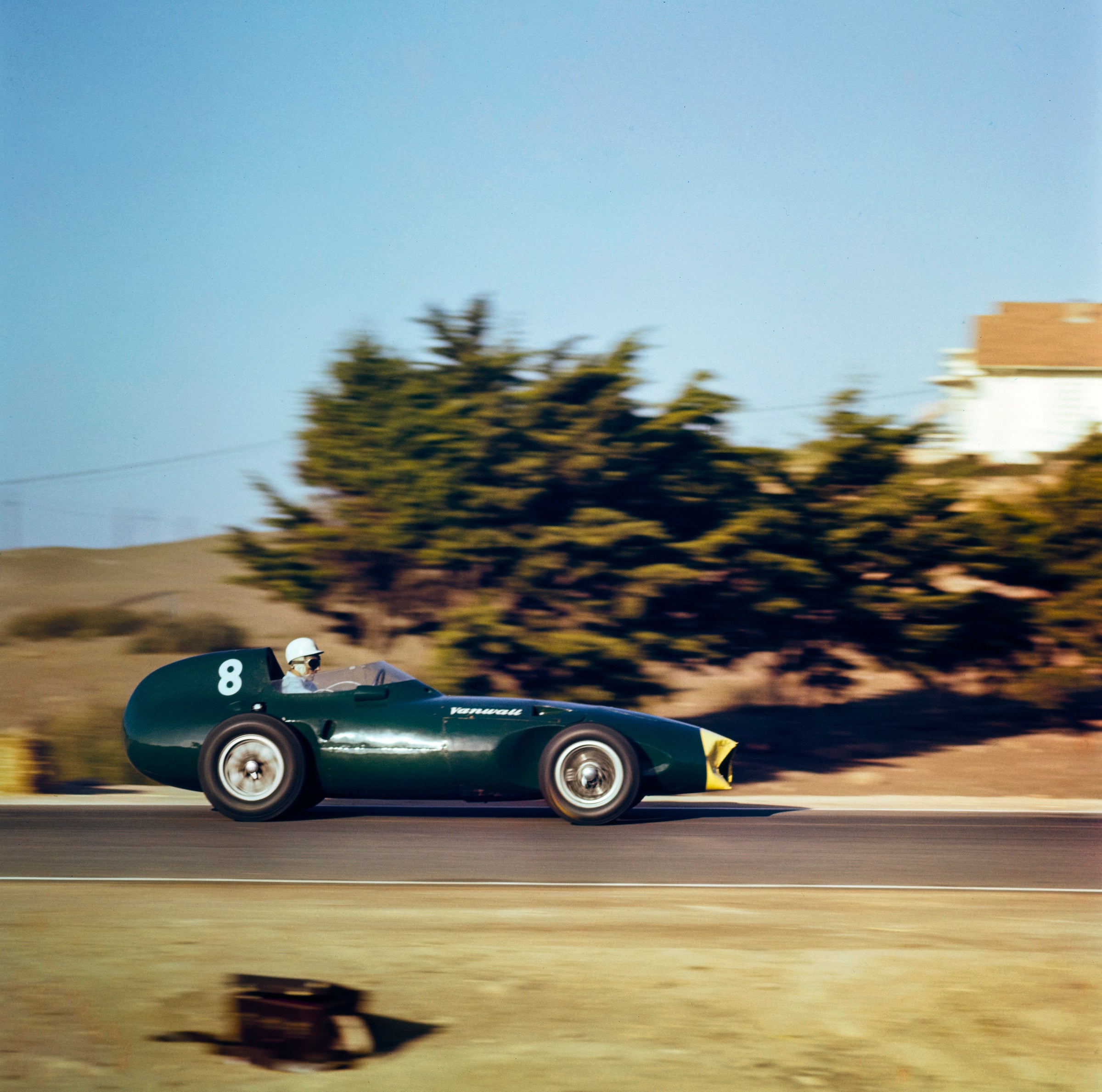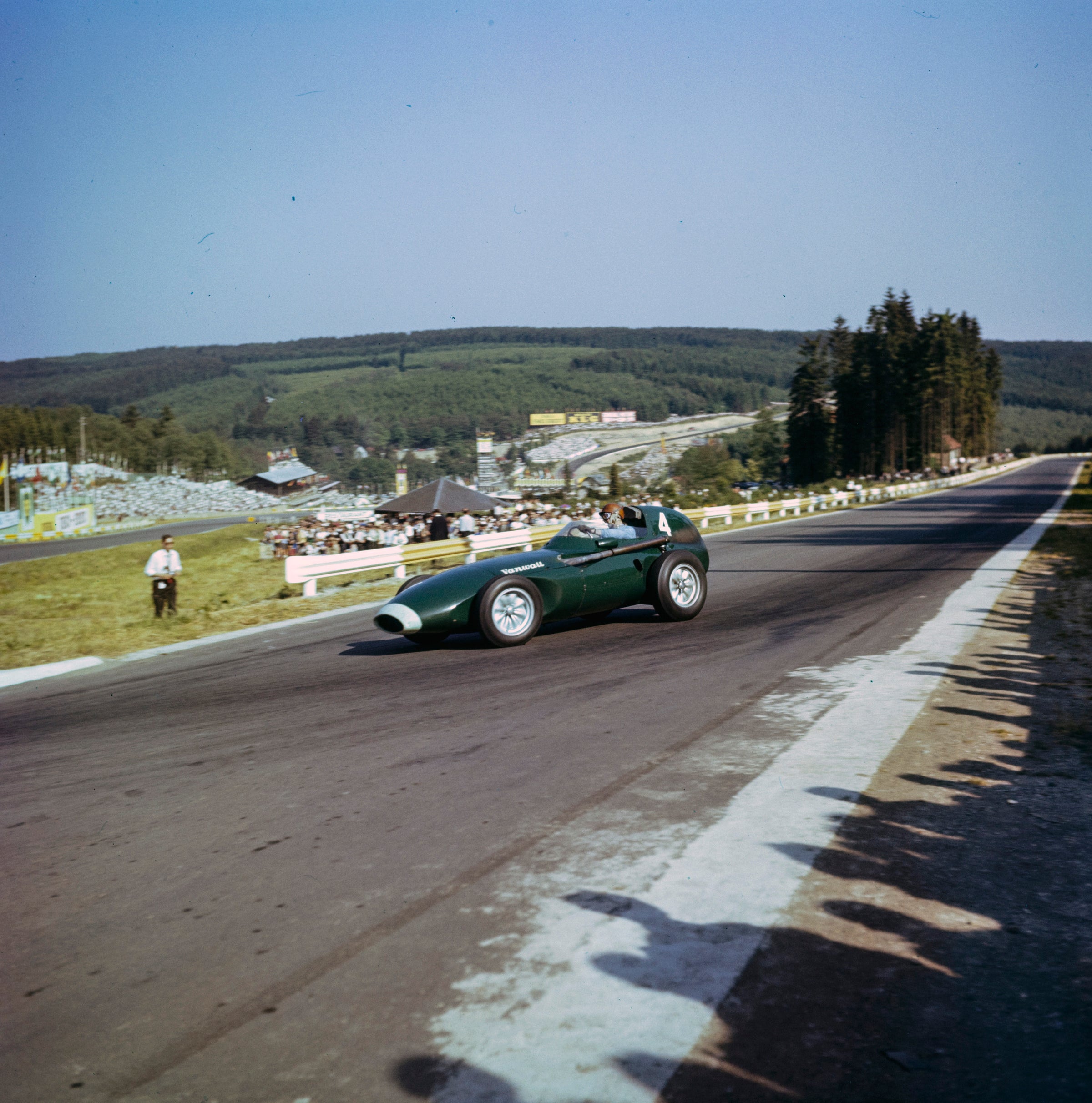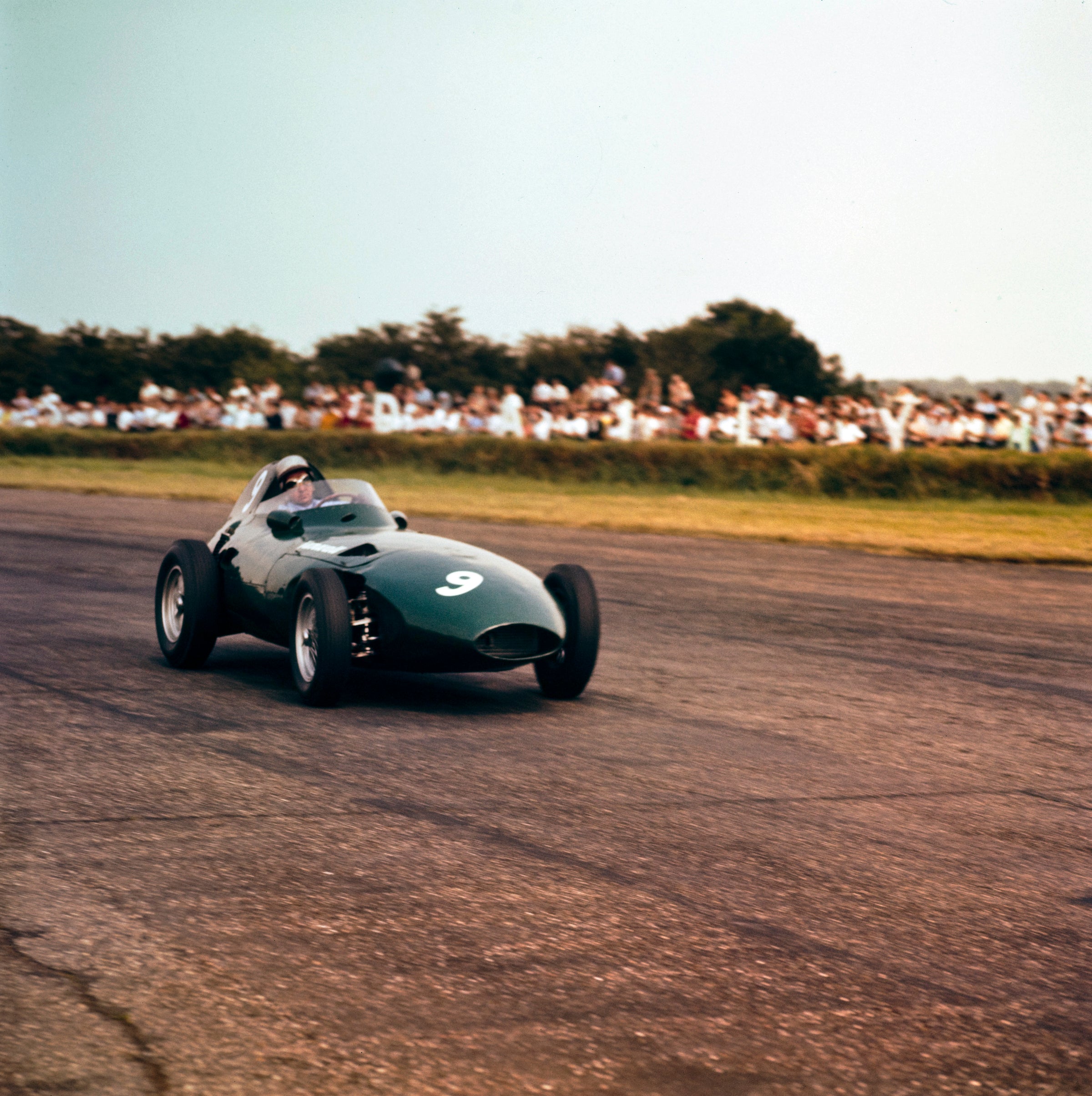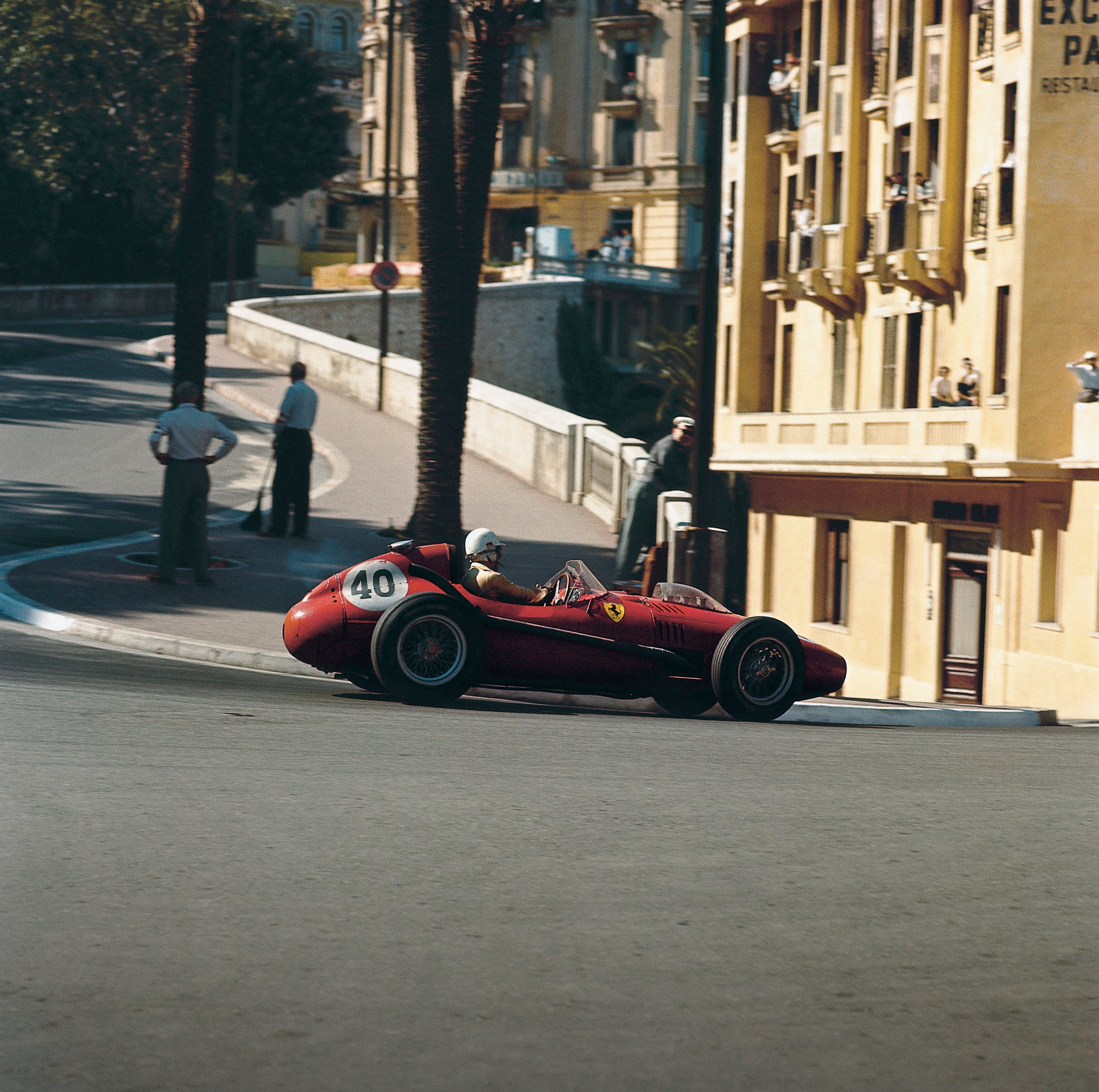
Formula 1: Car by Car 1950–59
- In stock, ready to ship
- Inventory on the way
1958
HAWTHORN DENIES MOSS FOR BRITAIN’S FIRST CROWN
A number of new initiatives were ratified for the coming season when the FIA’s sporting commission met on 7 October 1957. Maximum engine capacities remained unchanged but commercial fuel was now mandatory, with aviation fuel soon standard. The new Constructors’ Cup was introduced with no points awarded for the Indianapolis 500 and just the leading car of each marque scoring points. The best six results counted for each championship. Shared drives were no longer rewarded with points. Finally, race duration was reduced to between 300kms and 500kms or a minimum of two hours, which purists saw as a retrograde move.
The 1958 season was a tragic if successful campaign for Ferrari. Luigi Musso and Peter Collins were both killed while racing and Mike Hawthorn lost his life in a road accident on 22 January 1959. Furthermore, Vanwall’s Stuart Lewis-Evans was fatally burned during the final championship round.
The Portuguese GP was included on the calendar for the first time on the long Porto street circuit, complete with cobbled streets, tramlines and varying track width. Originally slated for 29 June or 6 July, it was eventually postponed to 24 August. There was confusion over whether the races in Argentina would go ahead when the last ship left Europe for Buenos Aires in December. The Italians seemingly were never in doubt but the British believed the events had been cancelled: neither Vanwall nor BRM sent cars, leading the Royal Automobile Club to protest the Argentine GP’s inclusion in the championship, while the Italians and South Americans threatened to leave the FIA if the race was stripped of points status. In fact the GP was only confirmed as the opening championship round 11 days after it happened, following a meeting in Monaco on 30 January at which the Moroccan GP was also elevated to the championship. The whole process led The Autocar to describe the FIA as ‘astoundingly slow and unwieldy’. The Argentine fiasco, and the fact that four cars were delayed on the high seas, led to the smallest field in championship history – just 10 cars.
Silverstone was always keen to improve its facilities and Autosport reported that the ‘BRDC Members’ enclosure and refreshment tent was a popular innovation’ at the British GP. Less welcome was the announcement at the end of the year that the Daily Express was ending its sponsorship after 10 years. A welcome aspect of the year was Peter Ustinov’s Grand Prix of Gibraltar gramophone record, a parody with drivers ‘Juan Manuel Fandango’ and ‘Girling Foss’ among his imitations. However, Motor Sport had its reservations: ‘Alas, the fun has rather dated,’ it noted two years later, ‘jokes at the expense of Gordini making one feel ancient and, by jove, the thing does go on and on.’
SCUDERIA FERRARI
Enzo Ferrari held a lunch at Modena’s Ristorante Fini on 21 December 1957 at which he announced Peter Collins, Mike Hawthorn and Luigi Musso as his unchanged F1 line-up. Wolfgang von Trips, Olivier Gendebien and Phil Hill were retained as junior drivers and for sports cars. Promoted to chief engineer in May, Carlo Chiti worked with the legendary Vittorio Jano to refine the 1957 F2 car’s tubular spaceframe with a small-diameter superstructure. Suspension on the Ferrari Dino 246 was by coil springs at the front and transverse leaf/de Dion tube to the rear while Houdaille lever-arm dampers were standard. Ferrari experimented with rear coil springs on Hawthorn’s car during practice at the Nürburgring and subsequent races. Drum brakes were usual although Hawthorn persuaded Ferrari to try discs, which he raced in the last two GPs. The 2,417cc V6 engine developed 270bhp at 8,300rpm. The carburettors (first Weber, then Solex) protruded through the low-line bonnet, covered by a Perspex ‘bubble’. Englebert continued as tyre supplier. The Dino 246 was a bulky car and could not match the nimble rear-engine Coopers in the corners, but it was powerful and had an advantage on faster circuits.
Four Dino 246s were entered for the Argentine GP although von Trips’s chassis arrived after the race! Hawthorn and Collins qualified on the front row but Collins’s driveshaft snapped at the start. Hawthorn led briefly before understeer and fading oil pressure forced him to pit. Musso trailed Stirling Moss’s Cooper-Climax, the Italian convinced that Moss would change tyres, but when he realised late in the day that the little Cooper would not be stopping he gave chase from 30secs behind and finished just 2.7secs adrift. Hawthorn passed Fangio and Jean Behra to claim third place, despite contact with Carlos Menditéguy’s spun Maserati.
Ferrari sent singleton entries to the spring non-championship races at Goodwood, Syracuse and Silverstone, which Hawthorn, Musso and Collins respectively won against national fields.
With redesigned drum brakes, Ferrari struggled in qualifying for the Monaco GP. That said, Hawthorn recovered from being hit at the start to charge from eighth place to assume the lead when Behra’s brakes faded. He duelled with Moss before the Vanwall retired and set a new lap record only for a broken fuel pump to deny victory. Musso again finished second to take the points lead, with Collins third. Driving a fourth Dino, von Trips was on course to claim fourth, despite pain caused by his broken brake pedal, when his rough-sounding engine seized nine laps from home.
Three Ferrari entries were accepted for the Dutch GP, where the cars understeered and were slow on the straights. Gearbox failure caused Collins to spin at Scheivlak and both Hawthorn (fifth) and Musso (seventh) were lapped by Moss’s dominant Vanwall.
At fast Spa-Francorchamps, which better suited the Dino 246, long air intakes replaced the carburettor covers and Hawthorn led Musso in a scarlet qualifying 1–2. The start was a shambles as all the cars were left on the grid for an age. Autosport reported that ‘Collins’s car was boiling like a kettle’ but he fought with Tony Brooks for the lead for five laps until his overheating engine forced him to retire. Hawthorn slowed when Musso crashed into a house near Stavelot, thinking it was Mon Ami Mate Collins, and fearing the worst. He sped up as soon as he saw both team-mates by the side of the track and chased Brooks to the finish, setting the fastest race lap on the final tour despite his engine exploding as he exited La Source. Hawthorn coasted across the line to claim second. Driving a fourth car painted yellow at the behest of the organisers, Gendebien ran third until Stuart Lewis-Evans rammed him at La Source, but after losing three minutes for repairs he climbed back through the field to finish sixth.
Ferrari ended the run of British victories at Reims, where Hawthorn qualified on pole, led from start to finish and set the fastest lap. Von Trips was third but Collins, who spun down to 18th due to a loose air intake wedging under his brake pedal, lost fourth when he ran out of fuel on the last lap and pushed his car over the line to salvage fifth. Musso was second when he lost control at the fast first corner and barrel-rolled into a field. A dominant day ended on a sombre note when news broke that he had succumbed to his injuries.
Von Trips replaced Musso for the British GP but retired on his first visit to Silverstone. Collins took the lead at Stowe on the opening lap and led to the finish, while Hawthorn, who had tried Dunlop tyres in practice, was second and set the fastest race lap to assume the points lead for the first time.
With the Dino 246 now handling better and showing improved reliability, Collins and Hawthorn ran 1–2 in Germany after Moss’s retirement. Brooks passed both red cars on lap 11 and the Ferraris were chasing the Vanwall when Collins crashed at Pflanzgarten at over 100mph and was thrown clear and into a tree when the car somersaulted. Hawthorn saw the accident and retired, officially due to clutch issues. Collins’s death was confirmed during that evening’s prize giving. Motor racing had lost its ‘golden boy’ in another tragic race for Ferrari. Lacking oil and brakes, von Trips finished fourth. Phil Hill’s Dino 156 was lying fifth in the F2 class when delayed by a lurid spin near Adenau and dropping to ninth.
Moss dominated a dull race in Portugal that only came to life in the closing stages. Having crucially set a new lap record and running second, Hawthorn spun on the last lap at the uphill Boavista straight. He rolled the Ferrari against the direction of traffic, but on the pavement, as he refired the engine. Hawthorn’s second place was only confirmed at 11pm when Moss, who had stopped to watch the drama during his lap of honour, gave evidence to the stewards on his behalf. Just two Ferraris were sent to Porto and von Trips claimed fifth in the coil-spring car.
All four Ferraris entered for the Italian GP qualified in the top seven with Hawthorn on the front row and Hill, von Trips and Gendebien filling the next line. Both Hawthorn and von Trips used a new 2,451cc version of the V6 engine in the race. The opening lap could have been disastrous for von Trips, who collided with Harry Schell’s BRM at the first Lesmo and crashed into the trees, breaking his left leg. Gendebien stalled on the grid and was hit by Brabham, bending the Ferrari’s de Dion tube. Phil Hill made a tremendous start to his first F1 race and led the first four laps before his left rear tyre delaminated in the Parabolica. He set a new lap record (the first 200kph lap during a road race) as he climbed back through the field to lead once more before finishing third after his scheduled stop for rear tyres. Using disc brakes in a race for the first time, Hawthorn was on course for a victory that would have clinched the title when his clutch started slipping, leaving Brooks to steal the win and prolong the title fight to the final race in Casablanca.
All three Ferraris had old-specification engines for the Moroccan GP, where Phil Hill drove flat-out from the start in the hope of breaking Moss’s Vanwall. Forced down the escape road as he challenged Moss for the lead entering lap two, Hill regained second before deferring to let Hawthorn through and thus finished third once more. Hawthorn qualified on pole position and drove a conservative race to claim second and the world title. Driving the coil-spring car that was now fitted with Girling disc brakes, Gendebien spun on oil at the Brickyard corner and was hit by François Picard’s F2 Cooper-Climax, an incident that left the Frenchman seriously injured.
Hawthorn beat Moss by a single point once the best six scores were counted and Ferrari finished as runner-up in the inaugural Constructors’ Cup. ‘Well, I’m bloody glad it’s over!’ was Hawthorn’s reaction on the BBC evening news. A private luncheon with Queen Elizabeth and the Duke of Edinburgh at Buckingham Palace and accolades from the British racing establishment followed, before Hawthorn announced his immediate retirement from the sport on 9 December. Within two months he too would be gone, killed in a road accident outside Guildford.
VANWALL
The Automóvil Club Argentina only confirmed on 15 December 1957 that its races would be held as scheduled, and this late announcement, plus the switch to aviation fuel, meant that Vanwall was not ready for the opening championship round. Team leader Stirling Moss made alternative arrangements with Rob Walker but Tony Brooks and Stuart Lewis-Evans were left temporarily unemployed.
Vanwall modified its engines for the new fuel regulations and the auxiliary side tanks were redundant due to reduced race distances and improved consumption. The team switched from Pirelli to Dunlop tyres as the Italian company made a belated withdrawal. New alloy wheels were introduced at the start of the season but older Borrani wire fronts were generally preferred. High oil temperatures were initially a problem so a new tank was placed behind the radiator at Reims with access via a hinged flap in the bonnet. A whole new system was introduced in Portugal with a separate oil radiator beneath an air intake in the bonnet.
The team concentrated on championship races so made its 1958 début at Monaco, where the cars featured a short nose. Preparation was impeded when an air freighter bringing an engine for the spare car and new Bosch fuel injection systems crashed near Paris. Brooks qualified on pole position but all three Vanwalls failed before half distance. Ill on Saturday and only eighth on the grid, Moss recovered to pass Mike Hawthorn’s Ferrari for the lead only to have his engine drop a valve within five laps.
With just eight days available before the Dutch GP, the cars were flown back to London, overhauled in Acton and then freighted to Calais and onwards to Zandvoort by transporter. Vanwall confirmed its single-lap pace, especially on smooth tracks, by locking out the three-car front row with Lewis-Evans quickest. Moss was superb come race day: he took the lead from second on the grid and led throughout, shattering the lap record and lapping the Ferraris on the way to victory. Brooks was hit at the start and retired early while Lewis-Evans had a valve drop into a piston when third.
Moss led Brooks at the start of the Belgian GP only to break his engine when he missed a gear exiting Stavelot for the first time. Brooks then battled with Peter Collins’s Ferrari for a couple of laps before winning the fastest road race yet held in Europe with Spa-Francorchamps débutant Lewis-Evans third. Both remaining Vanwalls were lucky to finish for Brooks was stuck in third gear and Lewis-Evans had a broken wishbone as they limped across the line.
Vanwall’s mid-season dip in form then hampered Moss’s title challenge. Handicapped by lack of pace and overheating during practice for the French GP, neither Brooks nor Lewis-Evans finished although Moss salvaged second place behind the dominant Hawthorn so that the countrymen shared the championship lead. Moss took another pole at the British GP only for his engine to fail when running second. Lewis-Evans lost a race-long duel with Roy Salvadori so finished fourth while an off-form Brooks was seventh on another disappointing day.
Just two Vanwalls were entered at the Nürburgring due to a lack of engines. With previous handling difficulties at the circuit sorted, Brooks and Moss qualified 2–3. Moss was leading by 18 seconds on lap four when he retired at Schwalbenschwanz with, stated Motor Sport, ‘his magneto refusing to emit any more sparks’. Initially fourth, Brooks passed both Hawthorn and Collins to win his second GP of 1958. It was a sad day, however, for Collins succumbed that evening to injuries he sustained when he crashed while chasing the green car.
Having retired from the previous two GPs, Moss converted pole position into a much-needed victory in Portugal with Lewis-Evans third in qualifying and the race. Brooks spun and stalled at the end of the uphill Boavista straight on lap 36. Restarting against the flow of traffic or a push start meant disqualification, so he was out. Hawthorn had just set a new fastest lap and Vanwall’s Derek Wootton showed Moss ‘HAW-REC’ (HAWthorn RECord) on his board. Moss read it as ‘HAW-REG’ (HAWthorn REGular) so did not attempt to retake the fastest lap and gain a bonus point that proved crucial in the destiny of the World Championship.
Moss tried a Cosworth-designed Plexiglas-enclosed cockpit during qualifying for the Italian GP but reverted to standard configuration for the race. All three Vanwalls started from the four-car front row and fought with the Ferraris for the lead before Moss’s gearbox broke and Lewis-Evans stopped with an overheating engine. That left Hawthorn in the lead and on course to clinch the title in front of the Tifosi. But Brooks recovered from a 40sec pitstop to pass him with 10 laps to go, securing the inaugural constructors’ title for Vanwall and preserving Moss’s championship hopes until the final race in Morocco.
Moss needed to win the Moroccan GP and set the fastest race lap with Hawthorn third or lower. Moss achieved his part of the equation by leading from start to finish despite hitting Wolfgang Seidel’s erratic Maserati. Brooks fought Hawthorn for third before his engine blew up, leaving the Ferrari man to finish in a conservative second place and claim the title. Worse still, Lewis-Evans’s transmission seized during the closing stages and he crashed in flames. Badly burned as was extricated from the inferno, he was flown to England aboard a chartered Viscount but died six days later in an East Grinstead burns unit.
Moss, who Autosport reported ‘made certain of his umpteenth BRDC Gold Star’ by winning four GPs to Hawthorn’s one, was championship runner-up for a fourth successive season. Third in the standings, Brooks married Pina Resegotti in Pavia on 22 October.
In failing health and badly affected by the death of Lewis-Evans, Tony Vandervell announced Vanwall’s shock withdrawal from motor racing on 12 January 1959. The team did start a single GP in 1959 and 1960 but this important British marque would never be a force again.
COOPER CAR COMPANY
Cooper confirmed Roy Salvadori and Jack Brabham as its works F1 drivers for the coming season in October 1957 and the new Cooper T45-Climax was revealed to the press at the start of January. The frame and engine were lowered by 1½ inches, coil springs and double wishbones replaced transverse leaf springs at the front and the modified Citroën/ERSA gearbox was housed in a new Brabham-designed casing. A ZF limited-slip differential was used for the first time. Girling drum brakes were fitted at launch but discs were soon an alternative. When stretched to 2,207cc, the Climax FPF four-cylinder engine developed 194bhp at 6,250rpm.
After missing the Argentine GP, Cooper’s F1 campaign began on Easter Monday at Goodwood, where the T45s of Brabham and Salvadori finished 2–3 in the Glover Trophy behind Mike Hawthorn’s Ferrari. Second in non-championship races at Aintree (Brabham) and Silverstone (Salvadori), both qualified in the top four at Monaco. Salvadori caused mayhem at the start by entering the Gasworks hairpin too fast and running wide. Using the 2.2-litre Climax engine for the first time, Brabham finished fourth despite stopping to have the anti-roll bar reattached. Salvadori broke a track rod when he hit a couple of Vanwalls at the start and lost three laps for repairs before eventually retiring with gearbox trouble.
It was Salvadori’s turn to use the single larger engine at Zandvoort and he finished fourth. Brabham had surreptitiously used the ‘2.2’ to qualify fifth but trailed home eighth in the 1,960cc car. The high speeds of Spa-Francorchamps counted against the tiny green cars, which both used the smaller engine for this race. Salvadori ran as high as fourth but was delayed by a slipping clutch and Brabham, who had missed first practice through illness, had a blown head gasket. The Australian was sixth at Reims, where Salvadori had the 2.2-litre engine and lost a points score when the clutch failed but at least registered a finish by pushing the stricken car across the line.
The Cooper T45-Climax handled beautifully around Silverstone and Salvadori used the enlarged engine to claim an excellent third place with Brabham sixth. Ian Burgess, who ran Cooper’s racing school at Brands Hatch, retired a third T45 with another clutch problem on his GP début. Salvadori continued his fine form with the 2.2-litre T45 in Germany, where he inherited second; Brabham entered the F2 division at the Nürburgring and was joined by Bruce McLaren, who impressed by finishing fifth on the road to win the class. Relegated to the back of the grid for not completing enough laps in practice, Brabham crashed into Joakim Bonnier’s Maserati on the opening lap.
Brabham was handed the larger engine in Portugal but neither Cooper-Climax featured, Brabham seventh and Salvadori ninth with deranged suspension. They swapped engines once more at Monza where Salvadori inherited a distant fifth-place finish after several stops to cure overheating. Brabham broke his suspension when he crashed into Olivier Gendebien’s stalled Ferrari at the start. Four works T45s were entered for the final championship round in Morocco: Salvadori in the 2.2-litre T45, Jack Fairman in the smaller F1 car with Brabham and McLaren in the F2 class. Salvadori passed Fairman for seventh while Brabham clinched the Autocar British F2 Championship by leading McLaren in a works 1–2 among the smaller cars. Despite not using engines of the full 2.5 litres permitted in the regulations, Salvadori was fourth in the World Championship with Cooper-Climax third in the constructors’ standings.
ROB WALKER RACING
Stirling Moss agreed to race for Rob Walker in F1 events when Vanwall was absent so a late entry was made when the Argentine GP was confirmed as part of the World Championship and Tony Vandervell stayed away. Alf Francis modified the 1,960cc Climax FPF’s carburation to run on aviation fuel and fitted radius rods to the Cooper T43 to improve handling. The car was air-freighted to Buenos Aires where its reduced capacity meant little was expected. Accidentally poked in the eye by his wife and wearing an eye patch as a consequence, Moss qualified seventh. His car stuck in second gear for a lap early in the race before the ’box somehow freed itself, after which Moss ran non-stop to a shock win, slowing during the final laps to conserve his worn-through Dunlop rears. Luigi Musso’s Ferrari closed relentlessly but Moss held on to a famous victory by just 2.7sec. ‘Probably the most sensational upset in post-war motor racing,’ enthused Peter Garnier in The Autocar.
Moss beat Jack Brabham by 0.2sec in the Aintree 200 with Walker’s new Cooper T45, now powered by a Francis-modified Climax FPF featuring larger pistons that stretched capacity to 2,010cc. Vanwall entered the championship at Monaco so Maurice Trintignant replaced Moss although Walker’s T45 had the 1.96-litre engine once more. Ron Flockhart handled the Argentina-winning T43 but did not qualify. Trintignant qualified fifth and benefited as others faltered to score Walker’s second successive GP victory.
This unprecedented back-to-back success for a privateer entrant was so unexpected that Walker did not even have an entry for the following week’s Dutch GP but Trintignant was immediately invited to Zandvoort where he finished outside the points. Walker missed the next two rounds before returning at the British GP with Trintignant’s T43 a misfiring eighth at the finish. Moss used the T45 to win a minor race at Caen before Trintignant completed the World Championship campaign in Walker’s navy blue-and-white colours. Third in the German GP with the T45 powered by the 2,207cc Climax FPF engine, he was forced into the spare 2-litre T43 for the Portuguese GP when he hit a kerb in practice and bent the T45’s frame; in the race shock-absorber problems restricted him to eighth. Trintignant’s Cooper T45-Climax retired from the final two GPs of the season and he was seventh in the final standings.
Walker entered another T43 in the F2 sections of the German and Moroccan GPs. Wolfgang Seidel spun several times at the Nürburgring and was last when the suspension failed after nine laps. François Picard was running in the midfield at Ain Diab when Olivier Gendebien spun on oil. Picard crashed into the Ferrari and was airlifted with serious injuries. He made a full recovery after a lengthy stay in hospital but did not race again.
BRITISH RACING MOTORS (BRM)
Both Jean Behra and Harry Schell tested at Folkingham on 18–19 November 1957 and were announced as BRM’s lead drivers on 10 December. The four-cylinder BRM P25 was modified to run on AvGas with a five-bearing crankshaft replacing the previous four-bearing version but the revised engine proved underpowered. Tony Rudd introduced a new spaceframe chassis with detachable bodywork and modified the front suspension. The new chassis was stiffer and lighter than its predecessor and testing suggested that the revised front end was worth 1.5sec a lap around Silverstone. Shorter race durations plus improved consumption allowed for smaller fuel tanks.
BRM missed the Argentine GP and a pair of old-specification P25s arrived at Goodwood for the Easter Monday meeting. Behra led the Glover Trophy from the start but crashed into the chicane while Schell’s brakes jammed after seven troubled laps. Behra qualified a singleton BRM on pole for the Aintree 200 but lost second place to another brake failure. The Frenchman gave the first 1958-specification P25 its début in the International Trophy and led before a stone shattered his goggles. He finished fourth after stopping for another pair and for glass and blood to be removed from one of his eyes. Ron Flockhart’s old car was lying third when he crashed at Copse, avoiding Bruce Halford’s spun Maserati and attending marshals.
Two new cars were available for Monaco, where a confident Behra qualified on the front row despite hitting the wall at Tabac. He led from the start only for fading brakes (again) to end a fine drive and deny a breakthrough victory for driver and marque alike. Schell finished fifth after a long pitstop for engine attention, including a change of spark plugs. The team travelled direct to Zandvoort for the following week’s Dutch GP, where Flockhart was due to race the spare car but an administrative error meant only two BRMs were entered. Stirling Moss dominated with Schell and Behra second and third respectively. Despite the celebrations, Behra complained of a down-on-power engine and suspected preferential treatment for his team-mate. Relationships between the drivers grew ever more strained during 1958.
The BRMs handled well at Spa-Francorchamps but were handicapped by disappointing horsepower. Behra was shaken during Thursday practice when oil sprayed onto his left rear tyre, causing a frightening spin in the 160mph Masta kink and narrow avoidance of trees and a house. Behra made a good start but was passed by a reduced-capacity Cooper and a Lotus in a straight line. He was fourth when he gave up, making the spurious claim of falling oil pressure. Schell qualified seventh, ahead of his off-form team-mate once more, and finished fifth.
Maurice Trintignant joined Behra and Schell for the French GP as three 1958-specification cars were available for the first time. Two P25s had under-bonnet intakes for the Weber carburettors with the newest example having the oil cooler repositioned to the right of the engine. Schell qualified third, which prompted an angry Behra to demand the Franco-American’s car for the race. Schell led away but lost the lead to Mike Hawthorn on the opening lap and Behra battled with Moss for second before all three retired as morale sagged and the poisonous atmosphere reached breaking point.
Cylinder heads were modified for the British GP to improve mid-range torque with the oil cooler now to the left of the engine. The unfortunate Flockhart had been injured when he hit an ambulance during a sports car race at Rouen-les-Essarts so Masten Gregory took over the third P25 for the British GP but he too was hurt while practising for a support race. Schell continued to outshine Behra and he qualified second, ‘using all the road and quite a lot of the grass’ observed Denis Jenkinson in Motor Sport. However, rising oil temperatures and falling pressures restricted him to another fifth-place finish while Behra retired from the midfield after hitting a hare and puncturing a tyre. Two cars were immediately flown to Caen for the following day’s non-championship race, the scene of BRM’s first F1 victory 12 months earlier, but both retired.
BRM had not raced or tested at the Nürburgring and the P25 could not handle the bumps and jumps. Behra crashed through a hedge when he tried Schell’s car on Friday and eventually gave up after four laps with what ‘Jenks’ described as ‘driver boredom’. Had he continued, Behra would have finished second, such was the rate of attrition in the German GP. Schell made a tremendous start from the third row and was second by the time the cars disappeared around the Nordkehre but he suffered another brake failure.
In Portugal Behra held the upper hand for once. He qualified and finished fourth and was only denied second place when his engine lost its edge; Schell was sixth. On the opening lap of the Italian GP, Schell somersaulted into the trees at Monza’s first Lesmo corner when hit by Wolfgang von Trips’s Ferrari. Behra challenged for the lead before pitting for brake adjustment and was fifth when his clutch failed. Joakim Bonnier drove a third car in Italy and emerged unscathed when it caught fire.
The oil system was modified once again for the final race at Casablanca and there were twin air intakes on the bonnet. Behra qualified an excellent fourth but the frustrated Frenchman stormed away from his pit, and BRM, when he coasted in with a dead engine. Bonnier, again in a third car, and Schell both scored points, fourth and fifth respectively. Finally recovered from his Rouen injuries, Flockhart returned in a fourth P25 but retired.
Schell shared fifth position in the final drivers’ standings while BRM claimed a distant and disappointing fourth in the Constructors’ Cup.
TEAM LOTUS
Colin Chapman formed Lotus Engineering on 1 January 1952 with a small works behind his father’s pub (The Railway Hotel) in Tottenham Lane, Hornsey. He soon became renowned for lightweight sports-racing cars and the Lotus 11 was a class winner at the 1956 and 1957 Le Mans 24 Hours. The new F2 category was introduced for 1957 and Chapman launched his contender – the Lotus 12 – at the 1956 London Motor Show. He designed a light tubular spaceframe with double wishbone/coil spring front suspension, de Dion rear axle with radius rods and Girling disc brakes at all four corners, mounted inboard at the rear. The 1,475cc double-overhead-cam Climax FPF was originally driven through a BMC gearbox. Richard Ansdale soon designed a proprietary five-speed Lotus unit that was problematic and dubbed ‘queerbox’ by unhappy drivers. Keith Duckworth, a yoiung graduate from Imperial College, London, then introduced a new gearbox arrangement that improved matters but he left to form Cosworth Engineering in 1958. Magnesium alloy wheels also helped to save weight – Chapman’s obsession – and the third type 12 to be built featured an ingenious strut arrangement for the rear suspension, featuring coil springs, dampers and radius arms. Williams & Pritchard fashioned the sleek, low bodywork from Chapman’s drawings and Frank Costin’s interpretation.
The Lotus 12 was no match for contemporary Cooper designs during 1957 but Chapman was not deterred. He announced Lotus’s F1 graduation on 10 December 1957 using updated type 12s, initially powered by the enlarged 1,960cc Climax FPF. Cliff Allison signed as lead driver, supported by Graham Hill, who had run Lotus’s gearbox department before Duckworth.
Team Lotus made a disappointing championship début in the 1958 Monaco GP. Allison finished sixth (and last) having pitted to have a section of loose exhaust removed and spun into the straw bales at Massenet. Hill crashed at Le Portier when a half-shaft broke. Now using the 2,207cc version of the Climax engine, Allison was sixth in Holland and a surprise fourth at Spa-Francorchamps. That Belgian result could have been so much better as the three leading cars all had problems by the finish and could not have completed another lap. Hill retired his overheating car after numerous pitstops for water during the Dutch GP and blew his 1.96-litre engine in Belgium.
The Lotus men were the slowest two qualifiers for the French GP at Reims, where Hill had a new Lotus 16-Climax, and both exited the race with engine failures. The type 16 was a refinement of the previous design with its 1.96-litre Climax FPF both inclined (to reduce frontal area) and offset (so that the prop-shaft was to the driver’s left). The spaceframe was wider with suspension and disc brakes similar to those of the type 12, although the rear radius rods were longer. Costin again turned Chapman’s sketches into plans for Williams & Pritchard to fabricate the distinctive aluminium bodywork. Unfortunately, the Lotus 16 had inadequate cooling for engine and driver alike and was not a success.
Allison continued with the type 12 with enlarged engine at the British GP and qualified an encouraging fifth. Alan Stacey drove a third car – the second Lotus 16-Climax to be built – but all three Lotuses retired, the proximity of the gearbox having burned Hill’s backside for 17 uncomfortable laps. Denis Jenkinson observed in Motor Sport that ‘once again the Hornsey team did not exactly inspire anyone’. Allison switched to the 1,960cc Lotus 16 in Germany and started from the back after missing scrutineering. Eighth by the end of lap one, he was on course to finish second when his radiator sprung a leak. He finished 10th on the road (fifth in the F1 class) after stopping twice for water. Hill’s Lotus 16 was fitted with an F2 engine that overheated and then failed during practice, forcing him to spin. He then crashed Allison’s race car and eventually retired from the GP when an oil pipe broke.
The Portuguese GP was a disaster as Allison wrote off his new car in practice on the Boavista straight and Hill crashed out of the race. Allison borrowed a Scuderia Centro Sud Maserati 250F but gave up after 15 laps at the back of the field. At Monza Hill had a 2.2-litre type 16 with larger cockpit and revised exhausts while Allison was forced to use an F2 engine in his Lotus 12; the cars misfired throughout another troubled race but at least they finished, as tail-enders in sixth (Hill) and seventh (Allison) places. Both had 1.96-litre engines for the Moroccan GP and finished outside the points once more, Allison’s old car 10th and Hill a much delayed 12th in the type 16 after further overheating problems.
It had been a very disappointing début campaign for Lotus.
SCUDERIA SUD AMERICANA
The annual ‘Juan Manuel Fangio to retire’ stories began circulating as soon as the 1957 season had finished. With the five-time World Champion still undecided, his manager Marcello Giambertone leased two of the lightweight 1957 Maserati 250Fs for the Argentine Temporada and entered them for Fangio and Carlos Menditéguy under the Scuderia Sud Americana banner. Fangio qualified on pole position and led for 25 laps before dropping to fourth following a tyre stop. Menditéguy finished seventh after a couple of pitstops and contact with Mike Hawthorn’s Ferrari after a spin. After winning the non-championship Buenos Aires GP, Fangio hit headlines when Fidel Castro loyalists kidnapped him before the sports car Cuban GP.
Released after the event, Fangio returned in a Piccolo 250F for his final GP appearance at Reims. This brand-new chassis was first tested by Guerino Bertocchi at Modena, driven by Masten Gregory during practice for the Belgian GP and then taken to the Nürburgring on the day after the race for Stirling Moss. It was 1½ inches shorter than a standard 250F with lightweight, small-diameter tubes used in the new spaceframe. The front wishbones were fabricated in tube and sheet steel with Koni telescopic dampers inside coil springs at the rear. The straight-six engine was mounted further back and driven through a new five-speed gearbox. It was prepared and run by works mechanics but still officially entered by Scuderia Sud Americana. Fangio ran in the early slipstreaming battle for second before clutch and braking trouble restricted him to fourth at the finish. His retirement from F1 was confirmed by Giambertone on 23 July.
TEMPLE BUELL
Unsuccessful in an attempt to sign Stirling Moss for 1958, wealthy American Temple Buell effectively took over the Maserati Piccolo project when Juan Manuel Fangio retired from F1, the cars maintained and run from the works factory in Modena as before. Masten Gregory was originally intended as driver but he dislocated his shoulder when he crashed an Ecurie Ecosse Lister-Jaguar at Woodcote while practising for the British GP support race. Fangio’s Reims car, repainted in American blue and white, was entered into the Portuguese GP for Carroll Shelby, who lost a fine sixth-place finish on the penultimate lap when he locked his brakes and spun.
A second Piccolo chassis was built in time for the Italian GP, where Buell entered Shelby and the fit-again Gregory. However, Scuderia Centro Sud had prior claim to Shelby, who was forced to drive Signore Dei’s older 250F. Gregory was mighty with Buell’s Piccolo 250F during the early laps and challenged Mike Hawthorn for the lead despite increasing pain from his shoulder. Having already parked his slow Centro Sud 250F, Shelby relieved Gregory at his tyre stop on lap 47 and finished fourth. Originally disqualified as Shelby had not been entered in the car, Gregory/Shelby were reinstated a week later although shared drives no longer scored points.
For the championship finale in Morocco, Gregory had the choice of both new Maseratis, which sported an unusual new nose/radiator arrangement. He drove a steady race into sixth despite shock-absorber problems.
‘HORACE GOULD’
Maserati’s withdrawal eventually forced ‘Horace Gould’ to quit his privateer existence. He began 1958 by shipping his venerable Maserati 250F to Argentina where he finished ninth and last. Fourth in the non-championship race at Syracuse, he did not qualify a Scuderia Centro Sud 250F at Monaco. At the Dutch GP he handed his car to Masten Gregory, who Motor Sport reported was ‘on holiday in the pits’, but a broken fuel-pump drive ended the American’s promising climb through the field. ‘Gould’ withdrew from F1 although he would make a brief return in the 1960 Italian GP.
SCUDERIA CENTRO SUD
Guglielmo Dei’s Scuderia Centro Sud entered up to three Maserati 250Fs throughout the 1958 World Championship. The cars failed to arrive in time for the Argentine GP when the ship broke down in the Atlantic so the team’s first appearance was at Syracuse, where both Masten Gregory and Wolfgang Seidel retired, the American losing third place as a consequence. Both finished Silverstone’s non-championship race in May with Gregory continuing to show promise by taking third place in a strong field.
Three 250Fs were entered for the Monaco GP although Gregory was away winning the Spa sports car race with Ecurie Ecosse’s Lister-Jaguar. The Maserati 250F was clearly past its prime and Luigi Taramazzo, Gerino Gerini and ‘Horace Gould’ all failed to qualify. Not invited to enter the Dutch GP, Centro Sud’s three 250Fs were sent to Spa-Francorchamps for Gregory, Seidel and Maurice Trintignant, the Frenchman finishing seventh. Normally the quickest Maserati driver, Gregory had trouble firing his engine before the start and retired on the first lap. Seidel’s silver car was pushed away after four troubled laps.
It was all-change for the French GP for Gerini was back in the car Trintignant had driven in Belgium. Two rebuilt and immaculate blue-and-white 250Fs were on hand for Americans Carroll Shelby and Troy Ruttman (the 1952 Indianapolis 500 winner) to make their GP débuts. The cars only arrived in time for final practice and Shelby’s engine never ran cleanly although Gerini and Ruttman finished ninth and 10th. At Silverstone, Shelby was ninth despite being covered in oil from his down-on-power and smoking engine and Gerini’s gearbox broke when running last. Ruttman had visited John Eason-Gibson of the British Racing Drivers’ Club to arrange an entry but only two Centro Sud 250Fs were accepted.
With engine troubles having reduced the team’s serviceable equipment, Ruttman drove a singleton entry in Germany but he did not start due to another failure. Centro Sud sent two 250Fs to the Portuguese GP where both nominated drivers – Ruttman and Casimiro Oliveira – failed to arrive, so the redundant cars were handed to Maria Teresa de Filippis and Cliff Allison after they crashed in practice. Both withdrew early after unhappy runs at the back of the field. Ruttman was later suspended for a year by the United States Automobile Club for walking out on Centro Sud and bringing the sport into disrepute. Gerini and Shelby returned at Monza for another disastrous GP as Centro Sud’s season continued to unravel. Shelby spun at high speed when a stub axle failed in practice and he parked the undrivable spare car after just a lap of the race. Push-started off the grid, Gerini crashed at the Parabolica after two laps.
Replacing Shelby for the final race in Morocco and running last, Seidel was hit by Stirling Moss’s leading Vanwall when he swerved unexpectedly while being lapped for the second time. Gerini finished among the F2 cars, 11th of the F1 cars still circulating.
JOAKIM BONNIER
Joakim Bonnier acquired two Maserati 250Fs during 1958 – Chico Godia’s old car and the ex-Menditéguy/Scarlatti lightweight version. His début in the former car at Syracuse resulted in a distant second place behind Luigi Musso’s Ferrari. The final qualifier in Monaco, he crashed out of fifth place when he clipped a kerb in Casino Square. The car was rebuilt for the following week’s Dutch GP, where he lost the use of at least two gears during a troubled run. Bonnier took delivery of the newer 250F before the Belgian GP and finished outside the points at Spa-Francorchamps and in France. Second in the non-championship race at Caen, Bonnier retired from the GPs in Britain, Germany and Portugal (where he was unwell) before accepting a drive with BRM for the last two championship rounds.
Bonnier entered his older car for Phil Hill to make his GP début at Reims, the Le Mans winner finishing seventh after an unobtrusive race. Hans Herrmann experienced engine problems in Germany and Italy (when running sixth) and finished ninth in Morocco. Sports car driver Giulio Cabianca drove Bonnier’s second car at Monza and the retirement rate was such that he was fifth by the time he too suffered engine failure. Ulf Norinder also tried that 250F during practice for the Italian GP.
OTHER MASERATI PRIVATEERS
Moto Guzzi 500cc rider Ken Kavanagh acquired the third lightweight Maserati 250F and planned to enter himself in selected championship rounds during 1958. He took the car to Argentina where Jean Behra raced it into fifth place after a spin and unscheduled pitstop to adjust the suspension. Kavanagh retired from the Buenos Aires GP before finishing sixth in Syracuse. He qualified for the Belgian GP but did not start after a con rod breakage holed the engine during practice. That was his last appearance of the year and he returned to bikes after crashing out of the 1959 Glover Trophy at Goodwood. With BRM absent, Harry Schell also hired a private 250F for the Argentine GP, driving Luigi Piotti’s 1957 car into sixth at the finish without pitting.
Chico Godia began the season by finishing eighth in Argentina having run non-stop in his old Maserati 250F. He sold that car to Joakim Bonnier and acquired the newer lightweight version that Juan Manuel Fangio had raced in that year’s Temporada. Third on his début with his new car at Syracuse, he did not qualify in Monaco and was not invited by the Dutch organisers. The Spaniard then suffered engine failure in Belgium before his final GP appearance in France. He started 11th at Reims thanks to a qualifying time set by Fangio but crashed after 28 laps.
Maserati may have officially withdrawn its works team in 1958 but the company was happy to run paying customers with Nello Ugolini directing operations and Guerino Bertocchi responsible for preparation. The car Menditéguy had driven in Argentina was taken over by Giorgio Scarlatti from Syracuse, where he qualified second (3.3sec slower than Luigi Musso’s dominant Ferrari) and retired. He was just one of two Maserati drivers to qualify for the Monaco GP but his run ended in a spectacular engine failure as he approached Ste Dévote for the 29th time. A week later in Holland, Scarlatti spun into a wire fence behind the pits and was last when the rear axle failed.
Maria Teresa de Filippis became the first woman to race in the World Championship. Persuaded by Luigi Musso to buy a Maserati 250F, the V12 car now fitted with a six-cylinder engine, she finished fifth on début in the non-championship race at Syracuse. A non-qualifier for the Monaco GP after a piston failure, she finished 10th in Belgium. De Filippis crashed into a lamppost during practice for the Portuguese GP so borrowed Scuderia Centro Sud’s 250F but withdrew after six slow laps. She was running fifth in Italy when a broken con rod denied a points finish. Gino Munaron also tried her car during practice at Monza.
Monte Carlo-based businessman André Testut never looked like qualifying his 250F for the Monaco GP and local veteran Louis Chiron went 1.6sec quicker when he tried the car but that was still 4.8sec from making the grid.
B.C. ECCLESTONE
Bernie Ecclestone had intended to sell his recently acquired Connaught B-types in New Zealand. However, the 1957–58 Tasman races proved unsuccessful for Roy Salvadori and Stuart Lewis-Evans so Ecclestone ran the cars in the early English non-championship events of 1958. Archie Scott Brown and Lewis-Evans, the latter in the rebodied ‘toothpaste tube’, were fifth and sixth at Goodwood, but Silverstone’s International Trophy brought no success. Ecclestone obtained two entries for the Monaco GP but took only ‘toothpaste tube’, which neither Bruce Kessler nor Paul Emery could qualify, Kessler’s best time 4.5sec slower than required. Both Connaughts were taken to Silverstone for the British GP where Ivor Bueb (‘toothpaste tube’) and Jack Fairman retired early on.
Ecclestone drove a couple of slow laps during practice in Monte Carlo and at Silverstone but did not attempt to qualify on either occasion. The 1958 season ended with the death of Lewis-Evans, who was managed by Ecclestone, and for some years thereafter F1’s future ‘ringmaster’ concentrated on non-sporting business affairs.
PORSCHE SYSTEM ENGINEERING
Dr Ferry Porsche announced a limited F2 programme in April and a single Porsche 718 RSK was entered in the F2 class of the German GP. Designed by Wilhelm Hild, this sports racer had fully enclosed wheels, a central seating position and a spaceframe chassis. Fitted behind the driver, the 1,498cc double-overhead-cam flat-four engine was driven through a five-speed gearbox. Suspension was by trailing links and torsion bars at the front and double wishbones/coil springs to the rear, with telescopic dampers all-round.
Nominated driver Edgar Barth was injured in the previous week’s Freiburg hillclimb so Stuart Lewis-Evans, temporarily unemployed as Vanwall was running just two cars at the Nürburgring, practised before Barth was declared fit. Thirteenth overall on the grid, the East German’s Porsche was the second F2 car to finish when sixth on the road and 6.1sec behind Bruce McLaren’s class-winning Cooper-Climax.
ECURIE MAARSBERGEN
As was often the case, the organisers of the Dutch GP relaxed its selective works-only entry policy to add some local interest. From 1958, the main beneficiary was Carel Godin de Beaufort who entered his 1.5-litre Porsche 718 RSK two-seater sports car. He ran reliably at the back to finish 10th and last, six laps down. He also raced an older Porsche 550RS in the F2 class of the German GP but retired after three laps.
OFFICINE SPECIALIZATE COSTRUZIONE AUTOMOBILI (OSCA)
The Maserati brothers were concentrating on sports car racing by now and sports-bodied OSCAs were often entered in F2 races during 1958. Two such 1.5-litre, four-cylinder cars were entered for the Monaco GP for Giulio Cabianca and Luigi Piotti, but neither came close to qualifying and Piotti’s efforts included a spin on oil at Mirabeau. OSCA’s best F2 result of the year was Cabianca’s third place at Pau.
FORMULA 2 CLASS
The German and Moroccan Grands Prix both included a concurrent race for F2 cars. Works Ferrari, Cooper, Lotus and Porsche entries are detailed earlier in this chapter, along with those of Rob Walker Racing and Carel Godin de Beaufort’s Ecurie Maarsbergen. In addition, numerous privateers made up the numbers at the Nürburgring and Casablanca.
Cooper was the most popular F2 marque in 1958, invariably with Climax power. When not running Cooper’s racing school at Brands Hatch, Ian Burgess was campaigning a T43 in F2 for High Efficiency Motors, a Chessington-based precision tool-making company owned by former bike racer Tommy Atkins. At Snetterton in July Burgess beat a young pupil called Bruce McLaren but the roles were reversed a week later in the German GP, where the tutor finished third in class behind McLaren’s winning T45.
Tony Marsh, British Hillclimb Champion for the previous three years, acquired a new T45 that he brought home eighth overall and fourth in class at the Nürburgring. Brian Naylor, recovered from injuries sustained at Aintree in the spring, experienced teething problems with his T45 throughout the German GP weekend and retired at the end of lap one with a broken fuel pump. Dick Gibson and Christian Goethals both retired T43s, the latter driver entered by Ecurie Eperon d’Or.
Ivor Bueb was the first privateer to buy a Lotus 12-Climax that he entered under the Ecurie Demi-Litre moniker. He retired from the German GP with two laps to go.
Stirling Moss’s father (Alfred) and manager (Ken Gregory) announced plans for a new F2 team in January 1958. The British Racing Partnership (BRP) ordered a new Cooper T45-Climax to be driven by Stuart Lewis-Evans when Vanwall commitments allowed and otherwise by Tommy Bridger. The Moroccan GP was a tragic event as Lewis-Evans was seriously burned when his Vanwall caught fire and Bridger was one of those to crash when oil spilled onto the course. The T45s of local amateurs Robert la Caze and André Guelfi were the last two F2 finishers, third and fourth in class respectively.
• Year-by-year treatment covers each season in fascinating depth, running through the teams — and their various cars — in order of importance.
• Alfa Romeo: these supercharged 1½-litre cars dominated the first two years, with titles won by Farina (1950) and Fangio (1951).
• Ferrari: this new marque steamrollered the opposition in two seasons run to Formula 2 rules (1952–53), Ascari becoming champion both times, and took two more crowns with Fangio (1956) and Hawthorn (1958).
• Maserati: the fabulous 250F, the decade’s most significant racing car, propelled Fangio to two more of his five championships (1954 and 1957).
• Mercedes-Benz: the German manufacturer stepped briefly into Formula 1 (1954–55) and won almost everything with Fangio and up-and-coming Moss.
• Vanwall: green finally beat red when the Vanwalls, driven by Moss and Brooks, won the inaugural constructors’ title (1958).
• Cooper: the rear-engine pioneers signposted Formula 1’s future when Jack Brabham became World Champion (1959).
• Over 600 photos from the superb archives of Motorsport Images show every type of car raced by every team and driver, presenting a comprehensive survey of all participants.
Format: 280x235mm
Hardback
Page extent: 304
Illustration: 600 photos, including colour
We deliver to addresses throughout the world.
UK Mainland delivery costs (under 2kg) by Royal Mail £5.00.
Books will normally be shipped within two working days of order. Estimated delivery times post shipment. UK: Up to 5 working days. Europe, Northern Ireland and Highlands and Islands: Up to 8 days. USA: Up to 12 days
IMPORTANT NOTICE FOR EU CUSTOMERS: Delivered Duty Unpaid (DDU) means that customers are responsible for paying the destination country's customs charges, duties. Regrettably parcels will sometimes be held by customs until any outstanding payments are made. Any payments not received may result in courier returning or in some cases destroying your books.
Unwanted products can be returned with the original packaging within 14 days of delivery. Returns will be at your own cost.
If you receive a faulty or damaged item please contact orders@evropublishing.com for return and replacement information.








